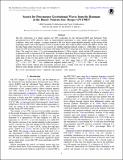Search for Post-merger Gravitational Waves from the Remnant of the Binary Neutron Star Merger GW170817
Author(s)
LIGO Scientific Collaboration; Virgo Collaboration; Aggarwal, Nancy; Barsotti, Lisa; Biscans, Sebastien; Buikema, Aaron; Demos, Nicholas; Donovan, Frederick J; Eisenstein, Robert Alan; Essick, Reed Clasey; Evans, Matthew J; Fernandez Galiana, Alvaro-Miguel; Fritschel, Peter K; Gras, Slawomir; Hall, Evan D.; Katsavounidis, Erotokritos; Kontos, Antonios; Lanza Jr, Robert K; Lynch, Ryan Christopher; MacInnis, Myron E; Martynov, Denis; Mason, Kenneth R; Matichard, Fabrice; Mavalvala, Nergis; McCuller, Lee P; Miller, John; Mittleman, Richard K; Ray Pitambar Mohapatra, Satyanarayan; Shoemaker, David H; Tse, Maggie; Vitale, Salvatore; Weiss, Rainer; Yu, Hang; Yu, Haocun; Zucker, Michael E; ... Show more Show less
DownloadAbbott_2017_ApJL_851_L16.pdf (1.354Mb)
PUBLISHER_POLICY
Publisher Policy
Article is made available in accordance with the publisher's policy and may be subject to US copyright law. Please refer to the publisher's site for terms of use.
Terms of use
Metadata
Show full item recordAbstract
The first observation of a binary neutron star (NS) coalescence by the Advanced LIGO and Advanced Virgo gravitational-wave (GW) detectors offers an unprecedented opportunity to study matter under the most extreme conditions. After such a merger, a compact remnant is left over whose nature depends primarily on the masses of the inspiraling objects and on the equation of state of nuclear matter. This could be either a black hole (BH) or an NS, with the latter being either long-lived or too massive for stability implying delayed collapse to a BH. Here, we present a search for GWs from the remnant of the binary NS merger GW170817 using data from Advanced LIGO and Advanced Virgo. We search for short- (≲1 s) and intermediate-duration (≲500 s) signals, which include GW emission from a hypermassive NS or supramassive NS, respectively. We find no signal from the post-merger remnant. Our derived strain upper limits are more than an order of magnitude larger than those predicted by most models. For short signals, our best upper limit on the root sum square of the GW strain emitted from 1-4 kHz is at 50% detection efficiency. For intermediate-duration signals, our best upper limit at 50% detection efficiency is for a millisecond magnetar model, and for a bar-mode model. These results indicate that post-merger emission from a similar event may be detectable when advanced detectors reach design sensitivity or with next-generation detectors.
Date issued
2017-12Department
Massachusetts Institute of Technology. Department of Physics; MIT Kavli Institute for Astrophysics and Space Research; LIGO (Observatory : Massachusetts Institute of Technology)Journal
Astrophysical Journal. Letters
Publisher
American Astronomical Society
Citation
Abbott, B. P. et al. “Search for Post-Merger Gravitational Waves from the Remnant of the Binary Neutron Star Merger GW170817.” The Astrophysical Journal 851, 1 (December 2017): L16 © 2017 The American Astronomical Society
Version: Final published version
ISSN
2041-8213
2041-8205